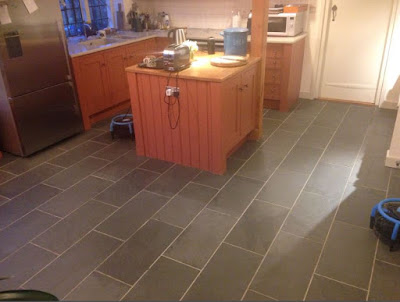This week Nathan was in Cambridge cleaning a slate kitchen floor. Before Nathan started the cleaning process he carried out a test area and used a special product to break down the topical sealer. The process worked but was a mission to get everything off. As Nathan was dealing with impregnator all of this topical seal had to be removed as the client had requested a matt finish.
What is slate?
Slate is catergorised as a fine grained, metamorphic rock which came about due transformation of an existing rock type. The original rock would have been subjected to immense heat and pressure causing a profound change, resulting in slate. Simple really! Slate is a totally natural product which has been used for hundreds, if not thousands of years in many different ways as a building material because of its appearance and durability.
As slate is found underground it has to be either mined or quarried. Mines can be found around the world, but according to recent figures 90% of Europe's natural slate used for roofing comes from the slate industry in Spain.
History of slate
For centuries, slate was mined in north Wales, Cornwall and Devon, which at one time had been famous for their mining towns and workers but with the gradual decline in production most underground slate mines were closed by the 1960s and late 1990s. Today, some open-cast quarries still remain open, these include the Penryn Quarry, Oakley in Blaenau Ffestiniog and Maenofferen Quarry which is owned by the Llechwedd tourist mine.
It's not known when slate was first used on floors but as slate has an extremely low water absorption rate, this unique factor makes the material waterproof and so not only is it good for floors but also for roofs.
The future of slate production
Historically slate has been used for many different things, but it has also been used as planters, coasters, gravel, chalkboards and something which is currently on-trend with designers is using slate as a eco friendly wall.
As slate is a finite material, it's reassuring to know that companies who continue to produce and supply slate to the building and construction industry are acting responsible and reducing the impact they make on the environment and are being aware of the sustainability issues.
For further information on the history of slate production National Slate Museum
Working for domestic or commercial
clients throughout Cambridgeshire, Essex, Suffolk and Hertfordshire.
For more information on our services contact our friendly team on
01223 863632 or email us at info@artofclean.co.uk
















